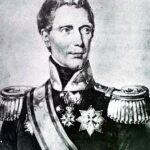CAMPBELL, ROY
- 4 Min Read
Roy Campbell (October 2, 1901-April 22, 1957) was a South African poet and writer. His vigorous verse was in marked contrast to the introverted literary style in vogue in the 1920s and 1930s.
Born in Durban, his full name was Ignatius Royston Dunnachie Campbell, and he was the son of Dr. Samuel George Campbell and of Margaret (Dunnachie) Campbell. When not attending Durban High School, he was raised in rural areas of either Natal or else Rhodesia (now Zambia and Zimbabwe).
At the age of 15 he ran away to join the Sixth South African Infantry, but was arrested in the Transvaal, and sent back to school. He was subsequently sent to Oxford University in England, but failed to secure admission, and instead settled in the south of France, where he lived for a time with some fishermen. Returning to England in 1922, he met and married Mary Margaret Garman.
The couple went to Wales, where they lived modestly and Roy took odd jobs to earn a living. It was at this time that he wrote and published his first book of verse, The Flaming Terrapin (1924), which was a notable success.
With his wife, he then returned to South Africa where, with two other writers, Laurens van der Post and William Plomer, he founded a literary monthly, Voorslag [Whiplash]. His editorship aroused controversy, however, and he was dismissed from the job. He then wrote a satire on South African cultural aspirations before returning to Europe in 1927. The satire, titled The Wayzgoose, was published in England in 1928.
He then settled in southern France where he earned his living from 1928-31 as a professional jouster in the town of Martigues. At the same time, he engaged in steer-throwing and bullfighting, and ran two fishing boats. In 1932 and 1933 he won the steer-throwing championship for the region of Provence and also bred and sold horses. (In his biographical entry in Who’s Who he listed his occupation as “horse merchant” and poetry as his “recreation.”)
Meanwhile he continued to publish his works in England. In 1930 he published a much admired volume of lyrical verse, Adamastor (1930), following this with The Georgiad (1931), which was on attack upon the coterie of English intellectuals known as the “Bloomsbury Group,” and which included among others the novelist Virginia Woolf and the art critic Roger Fry. He then published a book on bullfighting, Taurine Provence (1932), a further book of poems, Flowering Reeds (1933), and an autobiographical volume, Broken Record (1934).
He and his wife then moved to Spain, living at first in Barcelona. Having previously proclaimed himself a freethinker, he converted to Catholicism in 1935, and soon thereafter declared himself to be a Fascist. After the outbreak of the Spanish Civil War in 1936, he and his wife left for England, after having rescued the original manuscripts written by the 16th-century Spanish mystic poet St. John of the Cross [San Juan de La Cruz]. He returned to Spain, however, in the role of war correspondent for the British Catholic periodical The Tablet. After the Civil War he lived for a time in Spain and Portugal.
In the Second World War he became a private in the British Army in 1942, and then a sergeant with British Intelligence, serving in East Africa until 1944, when he was discharged for reasons of health. After the war he was a talks producer with the British Broadcasting Corporation from 1946-49, and then undertook lecture tours.
During this period he published another book of poems, Talking Bronco (1946), as well as a translation from the Spanish of the poems of St. John of the Cross (1951), which won him the Foyle prize for poetry. In 1952 he wrote a second autobiographical volume, Light on a Dark Horse, and in the same year moved from England to Portugal.
In this last period he produced some fine translations into English of the works of French and Spanish poets. In 1957 he was killed in an automobile accident near Setubal, Portugal. His poetic gift was widely acknowledged. His contemporary, Edith Sitwell, the renowned poetess, called him “a poetic tornado.” Another critic ranked his work highly, but also called it “reckless, violent, and congested.” Others felt that not since the appearance of the work of Olive Schreiner had such a valuable contribution been made to South African literature.
Highly individualistic, Roy Campbell was as unorthodox in his writing as he was in his opinions and in his personality. The intensity and vitality of his poetry aroused admiration, but many felt that his later volumes did not match the impact of his earlier work.
KEITH IRVINE




